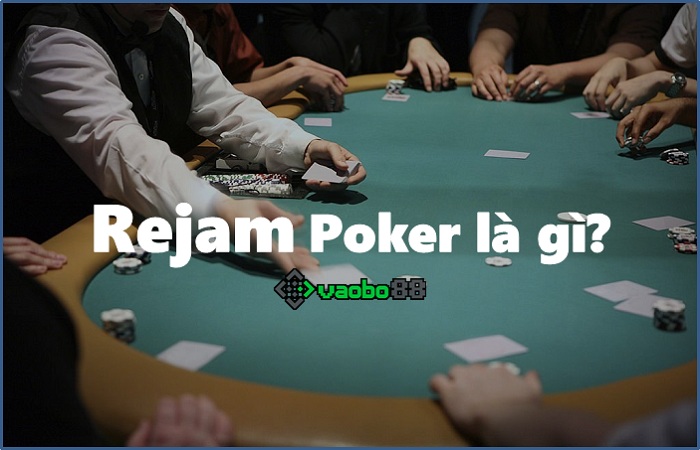What is Rejam Poker? This is understood as the act of a player making a 3-bet bluff to seize the chips and bets of the opponent in the stack.
Therefore, rejam is often confused with the resteal or steal tactics that players frequently apply.
So what is the actual form of rejam? At what point can you apply it to your gameplay to achieve good results?
Let’s explore the answer through the following shares.
What is Rejam Poker?
Rejam Poker is understood as the act of a player using a 3-bet bluff right at the Pre-flop round to steal the open-raise chips and blinds from other players.
This is a relatively proactive method, effective when you need to accumulate more chips as rejam is often used in MTTs and SNGs when the stack fluctuates from 15 – 25BB.
When should you use Rejam in Poker
Using rejam does not always yield good results for players.
In fact, the best opportunity you can seize is when the money bubbles or effective stacks are somewhere around 25BB.
At this point, the opponent has opened the pot with a bet of 2.5BB from the Co position, indicating that this player has a loose betting tendency as their ATS is only 45%, so the probability of them folding to a 3-bet is quite high, around 75%.

Meanwhile, you are in the BTN position and look down to find A5s, forcing the opponent to place a 3-bet bet according to the “script”.
A few other factors ensure success when rejam in this situation include:
- You are close to the bubble, and naturally, the general psychology of players will be to play less or fold due to fear of losing.
- The fact that players steal with a wide range only significantly reduces their defensive ability against a 3-bet bluff.
- Typically, players in the blind positions are very difficult, so you can only hope for a fold from both sides.
Situations where you should not Rejam Poker
Conversely, in situations where you should place a rejam, you need to pay attention to some cases where this tactic should not be applied.
With a 3-bet bluff, players need to have a sufficiently stable stack with a certain amount of chips if they want their calculations to materialize.
In cases where the stack is low, only 10 – 15 BB, this is the time you should consider giving up, folding your hand, or ending your rejam strategy.
In fact, rejam is greatly influenced by 3 factors: the opponent, the hand, and your position.
To understand more clearly, here are some specific shares:
1. Monitor the opponent
a) Playing style
The first thing to do is to classify and recognize the playing style of your opponent, thereby predicting their actions if you place a 3-bet.
Typically, tight players often set high standards and are not easy to give up when competing.
Therefore, you should prioritize choosing opponents with this characteristic.
In contrast to passive players who often call after you, you should carefully consider before applying rejam for yourself.
b) Stack
In all stacking techniques, stack always plays an important role because if the first player has a strong hand, folding with a 3 bet from the opponent is very unlikely to happen.
Similarly, for players who have not yet acted, having a large stack with good cards also makes it harder for them to give up their opportunities.
The perfect choice for you if you want to rejam is a medium stack because with a stack that is too small like 10BB, opponents are still willing to call until the end.
2. Evaluating Hands
There are quite a few hands that players will receive when participating in Poker to suit their rejam choices.
However, not every player has the skills and level to perfect the strategy if playing at ATC.
According to expert advice, I hope you do not feel too pressured and tired with the pair of Aces or KQ, AK,….
The best choice for players is suited Aces and Kings or wide hands to play rejam more effectively.
You also need to ensure you have enough capital whenever you need to call or bet more compared to the opponent’s previous action.
3. Analyzing Playing Position
The position of the player at each betting table Online Poker plays a huge role in influencing your success or failure.
For example, if a player sits at UTG and is ready to open the bet, it shows they have a relatively tight range.
In contrast, when sitting at CO or BTN, a wide range will make chips easier to be stolen.
Sometimes, the player’s position along with their playing tendencies can also provide many good signs for you when trying to predict and read the game.
Usually, the greater the distance between the open raise and the 3 bet, the more likely the opponent will fold their hand.
On the other hand, when considering the seating position of the player wanting to use rejam, I find that the earlier you sit, the more you can entice more players to participate in the 3 bet.
If at BTN you have the blind and the original raiser, then at UTG + 2 there are up to 7 other positions such as: MP, MP2, CO, BTN, SB, BB, and the original raiser.
Thus, bluffing a 3 bet in the late position is more effective.
Distinguishing Rejam and Resteal in Poker
Resteal is completely different from Rejam when you use them in Poker.
This is because resteal occurs when an opponent tries to raise their stack and steal it, but you are smarter by continuing to raise to steal it back.
Meanwhile, rejam involves all players at the betting table, creating a large stack for you to pocket.
Some other interesting Poker terms and techniques:
- What is Trash Hand in Poker?? Distinguishing between easy and hard trash hand cases.
- Details about the Steal Poker technique.
- C Bet in Poker: Practical examples and how to apply.
Conclusion
What is Rejam Poker has been explained in detail through the useful shares above.
To ensure effective play in Texas Hold’em, and to win every time, you need to keep in mind the notes and special cases that I have compiled in this article.
In addition, distinguishing between the rejam technique and resteal is very important as they have completely different meanings even though the way of playing is quite similar.








